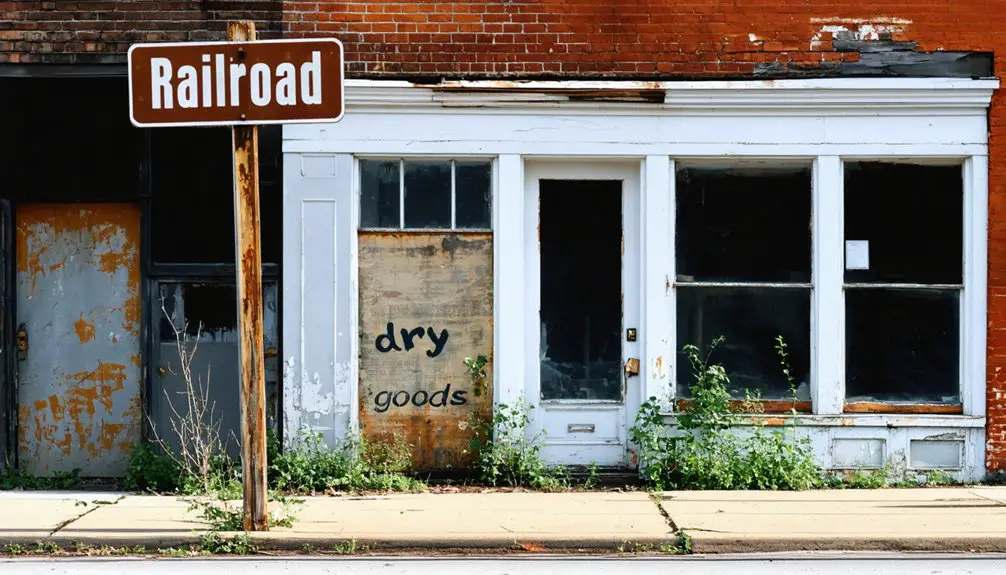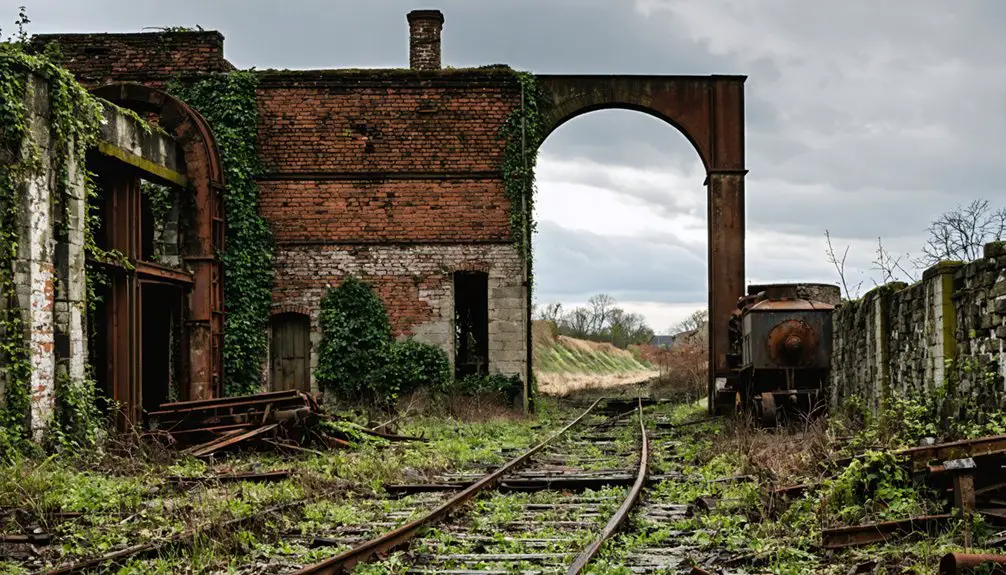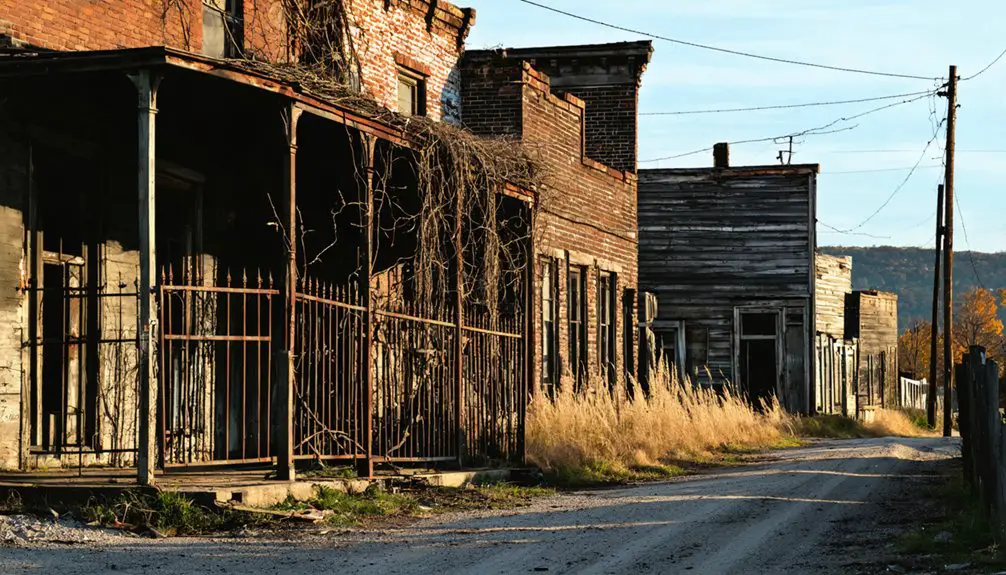You’ll find Sligo’s ghost town remains in Harrison Township, Clarion County, Pennsylvania, where it flourished as an iron manufacturing center from 1845 to the late 1800s. The Lyon, Shorb & Company established the Sligo Iron Furnace, producing up to 40 tons of pig iron weekly with 60-70 workers. The town, officially planned in 1871, grew rapidly with the arrival of the Sligo Branch Railroad in 1873. The site’s industrial heritage holds countless stories of Pennsylvania’s iron-making past.
Key Takeaways
- Sligo was established in 1871 as a planned industrial town centered around the Sligo Iron Furnace operations.
- The town’s growth peaked in 1873-1874 following the completion of the Sligo Branch Railroad.
- Sligo Iron Furnace, established in 1845, employed 60-70 workers and produced up to 40 tons of pig iron weekly.
- Key infrastructure included the Sligo Hotel, churches, a public schoolhouse, and a fire-brick factory.
- The town’s decline likely followed industrial changes, though specific ghost town transformation details aren’t provided in the background information.
Early Settlement and Pioneers
While the Mound Builders originally inhabited the area, Harrison Township’s European settlement began in 1801 with the first land grants, many awarded to Revolutionary War veterans.
Native Americans first called this land home before Revolutionary War veterans claimed Harrison Township through 1801 land grants.
You’ll find that George Leas pioneered Twin Creek’s settlement, followed by Tobias Tillman and his family in 1805. The rich bottomlands along Twin Creek and Swamp Creek drew early agriculture, with settlers strategically choosing locations near waterways for survival and transport. Permanent white settlers began establishing farms and homesteads around this time. Three creeks’ rich bottom lands were considered the finest areas for establishing early settlements.
Pioneer challenges included conflicts with Native Americans, as evidenced by raids near the riverbanks. Notable settlers like James Kerns, John Miller, and William Owns – known for his Native American relations and hunting prowess – established homesteads that shaped the township’s early development.
The population grew modestly from 357 in 1820 to 870 in 1840, reflecting the gradual nature of frontier settlement.
Birth of the Iron Furnace (1845)
The establishment of Sligo Iron Furnace in 1845 marked a pivotal industrial development along Licking Creek in Piney Township. Built by Lyon, Shorb & Company, this advanced facility showcased technological advancements in iron production through its steam-powered cold and hot blast systems. Like many ironworks of the era, the facility relied on skilled professional charcoal colliers to manage fuel production. Similar to the operations at Pennsylvania Furnace in Centre County, the ironworks utilized vast forest resources for charcoal production.
You’ll find it was strategically positioned to harness water power and local resources, setting new standards for efficiency in the region.
- Steam-powered blast technology combined hot and cold air for enhanced output
- Local iron ore, limestone, and charcoal fueled the smelting process
- Weekly production reached up to 40 tons of pig iron
- Employment supported 60-70 workers across various roles
The furnace’s creation transformed the local economy, providing jobs and essential iron products while connecting to broader markets through river transport systems.
Founding the New Town (1871)
Following twenty-six years of industrial operation, Sligo’s landscape underwent significant change when the original furnace company laid out plans for a new town in 1871. This bold town planning initiative kicked off with Thomas Berrean Sr.’s construction of the first house, soon followed by the company’s brick store building.
The completion of the Sligo Branch Railroad in 1873 enhanced the town’s transportation capabilities and economic prospects. Similar to Harrison Valley’s Davis & Co. planing mill, Sligo established its own industrial facilities.
You’ll find the new town’s rapid community growth reflected in key developments between 1873-1874: the Sligo Hotel, Methodist Episcopal and Presbyterian churches, a public schoolhouse, and J.B. Miller’s fire-brick factory near the railroad.
Religious and Educational Growth
As Harrison Township entered a period of spiritual awakening in 1889, contractors Nelson & Sylvanus Gardner constructed the area’s first church building, marking a significant milestone in local religious development.
The 1889 construction of Harrison Township’s first church symbolized a pivotal moment in the community’s growing spiritual consciousness.
You’ll find that religious diversity flourished as both Protestant congregations and Jewish families established their presence in the region. The Jewish community, though small, demonstrated remarkable educational collaboration by partnering with neighboring towns for religious schools and social support networks. The local Jews frequently traveled to synagogues in Tarentum for worship services. Today, these historical records are preserved through FamilySearch resources for genealogical research.
- Military veterans played key roles in early church congregations, creating post-war support networks
- Hebrew Ladies Aid Society and Omri Club emerged by 1915, strengthening community bonds
- Religious education extended beyond township borders through cooperative arrangements
- Sunday schools and revival movements boosted church participation and religious literacy
Municipal Development and Governance
Since its establishment in 1816, Harrison Township emerged as the oldest organized community in Southwestern Licking County, laying the groundwork for systematic municipal development.
You’ll find that the township faced significant municipal challenges as it evolved, particularly during its shift to First Class Township status in 1900, which brought enhanced governmental frameworks and services.
The governance evolution continued as Harrison Township adapted to serve its growing population, which now exceeds 10,000 residents.
Today’s administration manages approximately 7.2 square miles in Allegheny County, providing essential services like law enforcement, zoning oversight, and recreational facilities.
The Maronda Homes development continues to shape the township’s residential landscape with over 300 new housing units planned across 100+ acres.
While the township’s boundaries have changed since its original formation – with the creation of Lima Township in 1827 and Etna Township in 1833 – its commitment to local administration and community participation remains steadfast.
To minimize confusion with other Harrison Townships, the local government maintains clear geographical distinctions in all official documentation.
Geographic Features and Location
While two distinct places share the Sligo name in Pennsylvania, the ghost town of Sligo lies in southwestern Clarion County at 41.1077°N, -79.4933°W, nestled in a valley along Licking Creek.
The town’s topographic features include rolling hills characteristic of the region, with the creek forming part of the broader Clarion River watershed implications. You’ll find the settlement covers roughly 1.4 square miles of mainly terrestrial area, with minimal water coverage of just 0.23%.
- Pennsylvania Route 68 connects you northeast to Clarion (11 miles) and southwest to East Brady (13 miles)
- Route 58 provides westward access to Foxburg (13 miles)
- The valley setting along Licking Creek influenced the town’s historical development
- The location’s natural watershed system ties into the broader Pennsylvania river network
Economic Activities and Commerce

The economic foundation of Sligo emerged from its strategic valley location along Licking Creek in the late 18th century. When Colonel Forester built the area’s first sawmill in the 1790s, followed by a grist mill in 1798, these milling services transformed Sligo into a commercial hub for regional farmers.
You’ll find that agricultural commerce dominated the early landscape, with farming families relying on regulated crop associations and agricultural fairs to market their products.
By the mid-20th century, industrial development reshaped the economy as steel manufacturing, particularly ATI-Allegheny Ludlum’s facilities, became prominent. The region’s economic evolution continued through the 1980s, as deindustrialization led to diversification.
Today, healthcare, education, and retail sectors provide employment, while small businesses thrive along Freeport Road, offering residents additional opportunities through Pittsburgh commuter connections.
Transportation and River Trade
You’ll find Sligo’s early commercial success was heavily tied to its strategic location along the Allegheny River, which served as a essential transportation artery for lumber, iron, and oil shipments in the early 1800s.
By 1865, the river trade had reached impressive volumes, with merchants shipping over 380,000 pounds of iron and 441,570 barrels of oil through the area.
The river’s significance for local commerce remained strong until the 1870s, when the Sligo Branch Railroad created new shipping opportunities for the town’s metal products and raw materials.
River Transport Routes
During the 18th and 19th centuries, Sligo’s economic lifeline flowed through the Allegheny River, where canoes, keelboats, and flatboats transported settlers and cargo along this crucial waterway.
You’d find river navigation shaped by the current’s direction – downstream cargo moved easily by flatboat, while upstream travel required pack horses along Indian paths. By 1838, packet boats revolutionized cargo transport with horse-towed vessels docking at strategic points.
- Lumber rafting dominated commercial traffic, moving 3.5 million feet of timber in 1865
- Oil shipments exceeded 440,000 barrels during peak transport years
- Packet boats connected you to market hubs like Williamsport’s Market Street
- Horse relay systems along towpaths guaranteed continuous movement regardless of river currents
River traffic remained essential until railroads emerged as the dominant transportation mode in the late 19th century.
Shipping Metal Products
Moving beyond general river transport, Sligo’s iron industry pioneered specialized shipping methods for its metal products in the mid-1800s.
You’d find mule teams hauling pig iron from Laurel Hill furnaces to New Florence’s river ports, where workers loaded the metal onto barges bound for Pittsburgh and Ohio markets. The metal logistics operation relied heavily on purpose-built facilities, including the Sligo Iron Store Co.’s warehouses with their wide loading bays.
Iron distribution evolved when railroads arrived, offering year-round shipping alternatives to seasonal river routes.
You could spot teamsters, warehouse workers, and transport crews managing the constant flow of pig iron and finished goods like pots and horseshoes. This complex shipping network transformed Sligo into an essential link in Pennsylvania’s industrial supply chain.
Local Merchant Networks
While Sligo’s industrial might centered on iron production, its economic success hinged on sophisticated merchant networks that utilized the Allegheny River as their commercial backbone.
You’d find merchant collaborations flourishing through interconnected transportation systems, where river trade and railroad infrastructure created powerful trade partnerships. By 1865, the Allegheny River moved massive quantities of iron, lumber, and oil to Pittsburgh markets, while the Sligo Branch Railroad’s arrival in 1873 revolutionized local shipping capabilities.
- Steamboats and keelboats transported bulk cargo until 1868, carrying raw materials downstream.
- The Allegheny Valley Railroad enhanced distribution networks, running parallel to the river.
- Local merchants shipped timber products, coal, iron ore, and agricultural stock through combined rail-river routes.
- Telegraph lines along railroad routes accelerated communication between traders and regional markets.
Population Trends Through Time
Since reaching its peak population of 10,894 in 2000, Harrison Township has experienced a consistent demographic decline, with the population dropping to an estimated 9,790 residents by 2023.
You’ll find the most dramatic demographic shifts occurred between 1980-1990, when the township lost 11.2% of its residents. The COVID-19 pandemic accelerated this trend, with a 3.61% decline from 2020-2023, markedly outpacing the national growth rate.
Population projections suggest this downward trend will continue, with numbers expected to fall to 9,562 by 2025.
The township’s aging population, reflected in a projected median age of 49.6 years, along with steady outmigration of younger residents, continues to reshape the community’s fabric.
Harrison Township faces a demographic transformation as its population ages and younger residents seek opportunities elsewhere, fundamentally altering its social dynamics.
Despite maintaining a moderately dense suburban character, these changes present growing challenges for local services and tax revenue.
Historical Buildings and Landmarks

If you’re exploring Sligo’s historical structures, you’ll find most information centers on nearby Harrison Township landmarks rather than Sligo-specific buildings.
The area’s educational legacy is evident through transformed school buildings, including Natrona High School’s conversion to apartments and Birdville Elementary’s adaptation into a fire department.
While the historic Burtner House stands as the region’s most prominent preserved landmark, specific documentation of churches or the Sligo Hotel remains particularly absent from historical records.
Churches and Sacred Places
Religious institutions formed the spiritual and social backbone of Sligo during the late 19th century, with the town’s first major sacred buildings emerging in the 1870s.
The sacred architecture of both the Methodist Episcopal Church and Presbyterian Church, constructed in 1873, showcased brick structures that served as prominent landmarks for community gatherings.
Before Sligo’s establishment, Harrison Township already had religious roots with a Baptist church organized in 1803 and a Methodist congregation incorporated in 1855.
- The Methodist Episcopal Church featured rotating ministers including C.C. Hunt and S.J. Garnett
- Presbyterian leadership included Rev. J. Mateer and Rev. W.J. Wilson
- Both churches served as essential community centers for social and civic activities
- Church buildings were among the first structures built by the furnace company, highlighting their importance to early settlers
The Historic Sligo Hotel
A cornerstone of Sligo’s early development, the Sligo Hotel emerged in 1873 as part of the furnace company’s ambitious town planning initiative.
You’ll find this brick structure stood proudly among the town’s key buildings, including the new store and churches, serving as a significant community hub for both locals and travelers.
The hotel’s strategic location made it an integral part of Sligo’s industrial heritage, catering to workers and businessmen involved in the thriving charcoal furnace and metal shipping industries.
Beyond its architectural significance as a late 19th-century commercial building, it played a pivotal role in transforming Sligo from a simple industrial site into an organized borough by 1878.
The hotel’s presence helped define the town’s physical landscape while fostering social connections that shaped the community’s identity.
School and Educational Buildings
Throughout Harrison Township’s rural landscape, five historic one-room schoolhouses stand as symbols of 19th-century education, with construction dates spanning from 1840 to 1904.
You’ll find these simple yet functional structures scattered across Harrison and Crosby Townships, where they once served farming communities before educational consolidation transformed the region’s learning landscape.
- The 1890 Harrison School Building marked a shift from one-room schools to larger facilities
- One-room schools taught multiple grade levels simultaneously, adapting to rural population needs
- Local schools eventually merged into the Highlands School District, now centered in Natrona Heights
- Environmental challenges, including chromium-related air pollution, have impacted modern schools in the Karns area
The evolution from rural schoolhouses to centralized facilities reflects the area’s transformation from farming communities to Pittsburgh’s suburban outskirts.
Frequently Asked Questions
What Caused the Eventual Closure of the Sligo Iron Furnace?
You’ll find the furnace closed due to its inability to modernize from charcoal to coke-based iron production, coupled with economic decline from increased competition and depleted local resources.
Are Any Descendants of Original Sligo Settlers Still Living There Today?
While you’ll find descendant stories and family reunions in Harrison Township broadly, there’s no conclusive evidence of original Sligo settlers’ descendants living within the abandoned ghost town’s specific boundaries today.
What Natural Disasters or Significant Events Affected Sligo’s Development?
Like ripples on troubled waters, you’ll find no major catastrophes shaped Sligo’s story. While flood damage and mining accidents occurred occasionally near waterways and furnaces, these weren’t devastating enough to halt development.
How Did the Great Depression Impact Sligo’s Economy and Population?
You’d have seen severe economic decline hit Sligo during the 1930s, with unemployment reaching 40% and triggering significant population migration as families desperately sought work elsewhere, leaving behind deteriorating neighborhoods.
What Recreational Activities Were Popular Among Sligo Residents in the 1800S?
You’d find rural Pennsylvanians enjoying three main pastimes: church-hosted community gatherings, outdoor fishing trips along local waterways, and social events at the Sligo Hotel, which hosted over 50 gatherings annually.
References
- https://www.pa-roots.com/2011/04/11/chapter71clarioncounty/
- https://harrisontownship.net/index.php/about/history/
- https://harrisontwp.com/about/
- https://www.allegheny.pagenweb.org/Individual_Townships/Harrison.html
- https://en.wikipedia.org/wiki/Sligo
- https://ohiogenealogyexpress.com/preble/prebleco_hist_1881/prebleco_hist_1881_202_harrison_twpx.htm
- https://www.paintedhills.org/POTTER/HistHarrisonTwp.html
- https://www.compassinn.org/lvhs-blog/iron-furnaces
- https://centrehistory.org/article/pennsylvania-furnace/
- https://steelmuseum.org/pais300_exhibit_2017/clay_furnace.cfm



